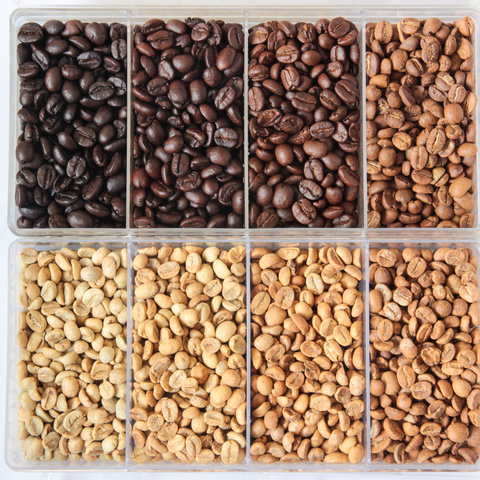A fresh cup of coffee is an important part of our mornings, we daily consume many cups of coffee. But few know what coffee beans are and where they come from.
This article will guide you on how coffee reaches your kitchen counter and how many phases it has to go through before coming to you. We will discuss coffee plantations and the phases it has to go through. Let's see how green coffee beans are grown.
Where does Coffee Bean Come From?
Coffee bean comes from a bush-like plant grown in a cool to warm tropical climate. The world's coffee bean belt is located in equatorial regions worldwide. Though it originated in Ethiopia, coffee is grown in North America, South America, Central America, the Caribbean, Africa, the Middle East, and South East Asia. Still, Ethiopia, Brazil, Vietnam, Indonesia, and Columbia are the top coffee producers in the world.
Brazil holds the number one position as the most coffee-growing country, with almost 5 billion pounds of coffee produced and imported worldwide.
How Does the Coffee Plant Look like?

Coffee plants are small and evergreen shrubs, almost resembling a Christmas tree. It's a bush with dark green waxy leaves. These plants are grown on a commercial level. Coffee trees can grow up to 30 feet. However, farmers keep it under 10 feet in height for better management.
With big thick leaves, the coffee plant bears white flowers and berry-like fruit. The fruit is green at the start and turns crimson red. The center of coffee cherries has one or two beans. These are coffee seeds known as coffee beans.
Types of Coffee Beans
We have more than a hundred coffee species, but they are generally divided into two types of coffee plants: Arabica and Robusta.
Arabica Beans
Arabica plants are the most cultivated coffee plants in the world. These are high-quality coffee beans and superior taste to any other kind. The seeds have an oval shape and a clear center marking. The size of the bean is bigger than Robusta beans. Arabica coffee beans have the most complex flavor. Their taste is a bit sweeter and far more aromatic than other species. The world's largest coffee chains use Arabica coffee beans due to their rich taste and complexity of flavor.
Robusta Beans
Coffea Canephora or Robusta coffee plants are a bit shorter in heigh. They are more bitter than sweet, and caffeine is also higher in this type of beans. Robusta coffee beans are generally cheaper. They are mostly used in commercial coffee products like instant coffee.
How are Coffee Beans Processed?

Coffee growers harvest the coffee flower and beans; processing must begin as quickly as possible. Coffee beans are processed in three ways depending on the country of origin of the coffee bean - different regions have different preferences of how they process the beans:
- Washed Process
- Natural Dry Method
- Honey Process
Washed Process
This type of process is more common in Latin America and African countries. It's the most common way to process coffee beans. After harvesting coffee cherry, they are sorted to remove beans. The process of fruit removal is called depulping.
Before depulping cherry flowers are washed, they usually do the "float test". Defected cherry flowers float on the top of the water, which is discarded. After the float test, the remaining flowers are depulped.
Depulped means coffee seeds are removed from the flower to be dried. Coffee fruit is sorted, and beans are removed within 24 hours.
After depulping, coffee seeds go to the fermentation plant for 12-36 hours. Fermentation softens the fruit mucilage that is still stuck to the beans, making it easier to remove in the washing process afterward.
After fermentation, seeds are submerged in water and washed thoroughly until all mucilage is removed.
After that, the seeds are laid out to dry in the sun. Coffee beans are dried until they are left with only 11% moisture, after which they are ready for roasting.
Washed coffee beans have a clean taste. It does not change the flavor of the coffee.
Natural Dry Method
It's the oldest processing method for coffee beans. In this process, the flower and fruit are not separated beforehand. It is left on the seed until the cherry is dried and separated from the seed.
Cherries are picked and spread on raised beds allowing air circulation. Once cherries are dried, the fermentation process happens. Cherries are dried until inside beans retain only 11% moisture. After which, coffee beans are sorted and bagged for shipping.
This type of coffee has a heavy flavor, also called a boozy or winy flavor. This process is common in Brazil, Yemen, and Ethiopia.
BTW, if you're eager to try different flavors of coffee each month, Parachute Coffee Limited Roast changes every month! Each month the beans we source come from a different region around the world! Try one today.
Honey Process
This process is between both natural dry and wash processes. The skin of the fruit is removed - similar to the washed process within 24 hours of harvesting with the mucilage still stuck on the seeds.
Instead of washing, coffee seeds are dried without flowers. Seeds are dried in the air or under the sun. After the fermentation and drying process, coffee beans are ready to be shipped to roasteries around the world. This method gives the beans a deep fruity flavor depending on how long mucilage was left on the beans. The process is common in Brazil and Costa Rica.
Testing for quality

After processing the coffee beans, they are sorted according to their weight and size. Defective coffee beans are separated. Coffee beans are bagged and sent to buyers at different destinations across the globe.
Upon arrival, cuppers in the coffee industry test these beans and look for freshness and quality. Cuppers can taste hundreds of coffee samples and point out the subtle changes. They separate coffee beans according to flavor profile.
There is a visual test that inspects the coffee beans. Then coffee beans are roasted, grounded, and submerged in cups of boiling water Cupper then judges the beans based on flavor, aroma, and taste. After thoroughly testing, beans are ready to be roasted.
Roasting Process

Roasting is the most crucial process for coffee beans. The quality of coffee beans depends largely on the type of roasting. Before roasting, coffee beans are spongy and green without any aroma. Unroasted coffee beans lack a distinct coffee taste despite having the same protein, amino acids, and caffeine as coffee beans.
Roasting develops the flavor character and color of coffee beans. This is where different flavor notes are achieved - through the roasting process.
It changes the chemical and physical properties of coffee beans. The type of roasts also determines the acidity level and caffeine kick.
Roasting occurs commercially at manufacturing plants. Coffee beans are also roasted on a smaller scale by boutique coffee shops. Some even roast it at home to experiment with the flavor and taste.
At Parachute Coffee, we roast our beans in small batches weekly and ship them right to your door. Click here if you'd like fresh roasted coffee. Use code WELCOME5 for $5 off your first bag!
Coffee beans lose 15-18 % of their mass on roasting. Though beans lose weight, they are doubled in size due to physical expansion.
Commercial coffee roasters are large machines that roast beans at controlled temperatures. Different flavors are created, and different names are given to beans depending on the gradation of the roast.
Light Roasted Beans

Light roasted are taken from the roasting machine earlier than the dark roasted beans. Lightly roasted beans are dense and have more moisture content. They tend to have a flowery taste.
The body and texture of coffee prepared with these beans are thinner than dark roasted coffee. Contrary to popular belief, lightly roasted beans have higher caffeine levels.
Dark roasted Beans
Darker roasts are lighter in weight but have heavy lifting. These are brown beans or even black, due to the roasting process. Moisture is dried as these are left in roasting machines for longer. Beans lose much of their moisture. Making them less dense. The level of caffeine is less. These coffee beans have a single note. Coffee is more bitter and smoky in flavor.
Read about the differences in the different roasts in our other article Espresso Beans vs. Coffee Beans.
How is Coffee Decaffeinated?
Decaffeinated coffee is the process done with a solvent or water. Beans are treated with solvents like methylene chloride. The solvent leached caffeine out of the beans. After the process, coffee beans are thoroughly washed to remove traces of solvent. And then they are roasted.
The other method is by steaming the coffee beans. The caffeine reaches the surface level as a reaction to steaming. The upper layer containing the caffeine is scratched off.
Final Words
A few coffee drinkers know how coffee reaches our kitchens. Knowing how hot coffee beans are harvested and the process they must go through before reaching us only makes us appreciate the cup of coffee more. Knowing more about the different types of coffee plants and how different processes affect the taste and flavor helps us understand coffee flavor and distinguish the subtleties.
Related Articles
How Do You Make Cold Brew In a French Press?
What Type of Alcohol Is Required for Coffee Syphon?
Espresso Beans vs. Coffee Beans
Love Coffee? Try Parachute Coffee Today!
Use coupon code WELCOME5 to get $5 off your first shipment! We hand select beans from around the world, roast them weekly, and deliver straight to your door! (Canada only)



